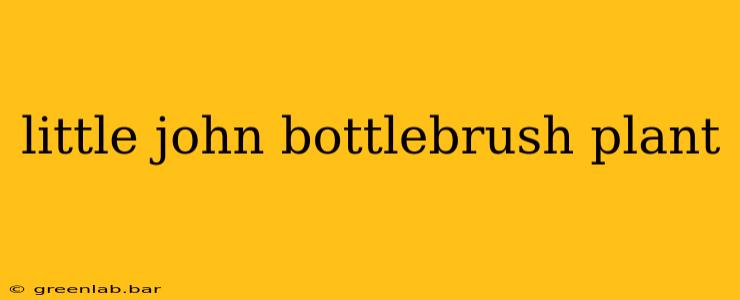The Little John bottlebrush ( Callistemon viminalis 'Little John') is a popular choice for gardeners seeking a compact, flowering shrub. Its vibrant red bottlebrush flowers and manageable size make it ideal for smaller gardens, containers, or as a low hedge. This guide delves into the care, propagation, and unique characteristics of this charming Australian native.
Understanding the Little John Bottlebrush
This cultivar is a dwarf selection of the weeping bottlebrush, boasting all the beauty with a significantly reduced footprint. Its weeping habit, with gracefully arching branches, sets it apart from other bottlebrush varieties. The striking crimson flowers, characteristic of the Callistemon genus, appear profusely throughout spring and summer, attracting pollinators like hummingbirds and bees. The glossy, dark green foliage provides a beautiful backdrop to these vibrant blooms. Reaching a mature height of only 1-2 meters (3-6 feet) and a similar spread, the 'Little John' remains relatively compact, making it exceptionally versatile for landscaping.
Growing and Caring for Your Little John Bottlebrush
Sunlight and Soil:
Little John thrives in full sun to partial shade. At least six hours of direct sunlight per day are ideal for abundant flowering. Well-drained soil is crucial; poorly draining soil can lead to root rot. It tolerates a range of soil types, from sandy to clay, but amend heavy clay soils with organic matter to improve drainage and aeration.
Watering:
Regular watering, especially during establishment and hot, dry periods, is important. Once established, it becomes more drought-tolerant but benefits from occasional deep watering during extended dry spells. Avoid overwatering, which can lead to root problems.
Fertilizing:
A slow-release fertilizer applied in spring provides essential nutrients for healthy growth and flowering. Avoid high-nitrogen fertilizers, as they can promote excessive leaf growth at the expense of flowering. A balanced, low-nitrogen fertilizer is recommended.
Pruning:
While not strictly necessary, light pruning after flowering can help maintain the desired shape and size, encourage bushier growth, and remove any dead or damaged branches. Heavy pruning should be avoided as it can negatively impact flowering.
Pests and Diseases:
Generally, the Little John bottlebrush is relatively pest and disease resistant. However, occasional infestations of aphids or scale insects might occur. These can usually be managed with insecticidal soap or horticultural oil.
Propagating Your Little John Bottlebrush
Propagation is readily achieved through cuttings. Take semi-hardwood cuttings in late spring or early summer. Dip the cuttings in rooting hormone and plant them in a moist, well-draining potting mix. Maintain consistent moisture and humidity until roots develop, typically within several weeks.
Little John Bottlebrush in Landscaping
Its compact size and attractive flowers make the Little John bottlebrush a versatile plant for various landscaping applications:
- Foundation plantings: Plant it near the base of your home to add color and texture.
- Container gardening: Perfect for patios, balconies, or decks.
- Low hedges: Create a neat and colorful low hedge along pathways or borders.
- Mixed borders: Combine it with other flowering shrubs and perennials for a vibrant display.
Conclusion: A Little Gem for Your Garden
The Little John bottlebrush offers a delightful blend of beauty, low maintenance, and versatility. Its manageable size, vibrant flowers, and adaptability make it a prized addition to any garden, regardless of size or experience level. With proper care, this charming plant will reward you with years of colorful blooms and aesthetic appeal.

